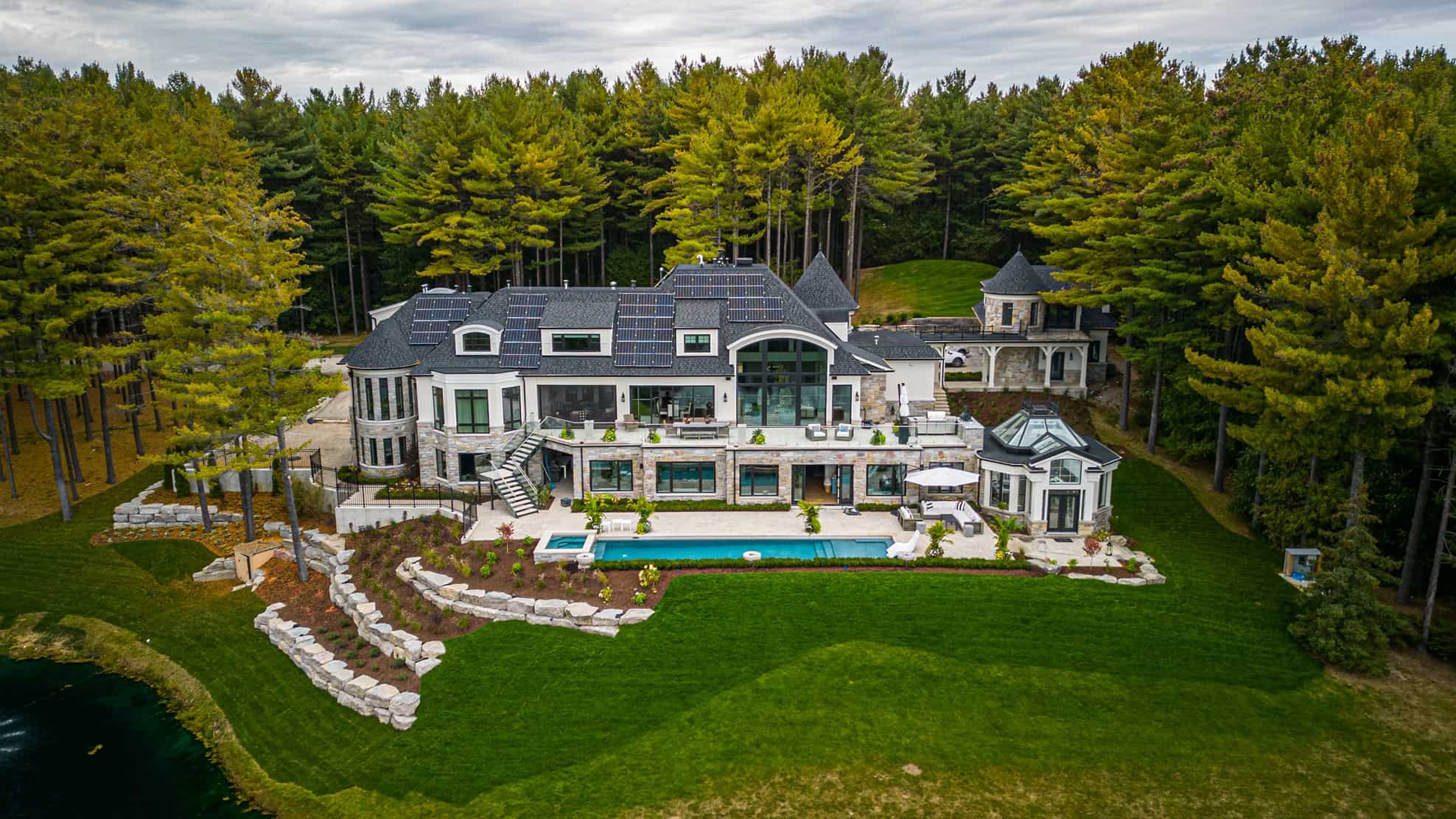Net zero ready homes and net zero homes are growing in popularity across the country and for a good reason. In fact, Canada has more than 1000 single-family net zero homes. As a cold climate country, Canada is a leader in net zero energy buildings. According to studies, new home buyers prioritize home energy efficiency.
Secondly, government incentives like Greener Homes Grant often make home energy-efficient renovations accessible to property owners. As the techniques and products used to achieve net zero continue to evolve, trained renovators and professional builders will become more creative with the construction designs they implement for their clients.
What are net zero homes?
The Net Zero program under the CHBA ( Canadian Home Builders Association) is the result of many years of in-the-field experience, trial and error, building passive houses, scientific research, and prior programs such as R2000. The net zero concepts is a responsible approach to energy saving and being environmentally conscious.
Generally, net zero homes are approximately 70- 80% more energy efficient than traditional properties. In fact, on an annual basis with rooftop solar or wind generation, a net zero home can generate as much energy as it uses. They use renewable energy systems to generate the energy they need. These can be photovoltaic systems ( Solar panels) or wind generators.
With ethically sourced and non-toxic materials, organic low-carbon materials used in net zero homes can affect a large carbon emission reduction. As a result, these homes are cushioned from increasing energy prices and are attractive to those seeking to be climate-friendly. That’s one way net zero homes can save you money.
Moreover, net zero buildings are designed and built exceptionally tight, with minimal air leakage. The air tightness of the home must be measured by a qualified 3rd party and pass rigorous testing. Thus, homeowners can enjoy a healthy indoor climate, a comfortable living environment, and silence from exterior noise.
Reducing the buildings’ energy consumption with energy efficiency features brings many benefits far beyond saving on heating fuel. These are some of the elements that make net zero homes the ultimate choice for homeowners seeking comfort and zero emissions.
Features of net zero homes
All net zero homes have three main objectives; use renewable energy systems, minimize energy requirements, and operate efficiently. This building concept is simple but not easy – that is, if you decide to do it yourself. Professionally trained builders make sure a net zero home has the following features.
1. Bioclimatic architecture
This may sound redundant, but bio-climatic architecture is a key result of net zero buildings. By designing carefully connected to the localized climate and natural environment, it’s possible to not only save energy but enhance the quality of life. That means designing a home using natural light during the day while minimizing energy loss.
On lots where there is freedom the orientation of the home can be tailored, and carefully-placed sun protections, and absorbing or reflective materials ensure that a building can passively take advantage of natural light and other natural resources.
2. Onsite renewable energy source
At the heart of the net zero building concept is that homes should address all their energy requirements by generating sufficient energy from on-site renewable energy sources like solar panels. For example, a home can have high-efficiency solar panels on the roof to convert sunlight to electricity. Alternatively, local wind systems or other reliable renewable energy sources. With renewables the average family home can cut its consumption by 70-80% and with a careful solar design can generate enough on an annual basis for a net zero energy use.
A single-family home’s energy requirements are calculated annually, which means it can export the excess energy to the electrical grid. The exported energy is credited to the utility when the home is generating sufficient energy. However, this doesn’t mean that all net zero homes should be huge power plants for the electricity grid. Energy efficiency is a key element of the net zero concept.
3. Energy-efficient equipment and lighting
When talking about power generation, it’s impossible not to talk about the overall energy efficiency of equipment and appliances. First, we minimize the home’s energy demand then we achieve a balance between energy generation and consumption. Part of the energy reduction is the use of high-efficiency appliances and light fixtures.
Therefore, acquiring high-efficiency equipment like refrigeration, lighting fixtures, HVAC, and other installations will require less electrical energy than low-efficiency appliances. For instance, a geothermal water source heat pump can be as high as 500% efficient. Cold water in the ground is heated by rejecting heat from the home and therefore air conditioning the home. Vice versa in the winter the relatively warm water in the ground is cooled and the heat is pumped into the home hence heating the home. And all this without the risk of water pollution!
4. Seal up the shell
In addition to generating clean energy, it’s essential that the entire home is energy efficient. A carefully-designed envelope is crucial for the home’s energy efficiency. For instance, a building that’s well insulated loses a low amount of heat to the environment and minimizes space heating requirements.
Thermal inertia is considered in the advanced energy review of a home’s design. Ceilings and walls can retain and release heat when necessary so their thermal mass can be used to enhance indoor comfort. One of the largest contributors to heat loss and heat gain is air tightness. Tighter homes have become a key solution to energy conservation. Sealing up the shell not only saves energy in net zero building but enables control of the indoor climate.
5. Well-insulated windows and walls
Properly insulated walls and windows are a key component of efficiency. Although triple-glazed windows are not a requirement of Net zero building design they are part of an energy efficiency strategic plan. Other high-efficiency windows can be installed but the performance characteristics must be carefully reviewed.
The trend in home design is too large windows, much to the chagrin of the energy modeller! ( bigger windows = more energy loss) Windows are a crucial lever to optimize a home’s energy savings and also the occupants’ quality of life. The spotlight is on window performance and which high-efficiency windows are best. Considering the average wall provides anywhere from R20 – R30, whereas a window at best is R5.
Some programs give points for the passive winter solar gain of windows, however, to regulate indoor temperatures successfully uncontrollable solar seems to be counterintuitive.
It’s our settled view that high-efficiency windows ( preferably triple-glazed windows) with sun-blocking characteristics, high u values and higher condensation resistance provide the best combination for a healthy indoor climate along with reducing a building’s energy consumption.
Benefits of net zero homes

Most net zero homes generate as much green energy as they use. Every part of the home works together to ensure consistent indoor temperatures, prevent drafts, and efficiently filter indoor air to eliminate allergens, pollen pm2.5 particles and dust. The results? With rooftop solar exceptional energy performance and ultimate comfort – a house is at the forefront of sustainability. All this adds up to an outstanding living experience. Here are other benefits of net zero homes.
Exceptional value
We mentioned previously that a zero net home generates as much energy as it uses and is about 70-80% more energy efficient compared to conventional homes. With such a home, energy demand and with it, utility bills will automatically fall to an all-time low and, yes, stay low all year long. It cushions the owner from future energy price increases. This can save you thousands of dollars in the long run.
Net zero homes are also built to higher standards than most conventional houses. That means they are more durable –less air leakage with warm, high-efficiency windows and properly insulated roofs and walls and incorporating many energy efficiency features.
Better comfort and healthy living
Carefully-designed net zero homes deliver exceptional comfort to their occupants all year long. Carefully chosen construction materials, advanced construction techniques, and superior cooling, heating, and ventilation equipment ensure consistent temperatures throughout the home. The advantages of energy efficiency are clearly experienced!
Also, exceptional air quality supports comfort and healthy living. Each home has an inbuilt filtered fresh air system that eliminates asthma triggers and allergens such as pollen, dust, and other forms of outdoor air pollution.
A carefully insulated and tightly built net zero building is quieter. Nearly all forms of noise like lawnmowers, traffic, and barking dogs in the neighbourhood are virtually silenced.
Environmentally responsible home
A net zero energy house with low carbon materials means you are doing your duty to protect the environment and preserve natural resources for future generations. With some precise energy engineering, all of net zero house’s features work together to minimize a household’s environmental footprint.
Wrap up
Net zero homes are built with an eye toward energy efficiency and conservation. This doesn’t necessarily mean these homes are entirely off-grid. They’re connected to the grid, sending excess energy to the grid when producing more energy than they need and drawing from it when they need more energy. As long as the annual net-energy use is zero, the house can be called a net zero house.






